| Didymocarpoideae | |
|---|---|
.jpg.webp) | |
| Cyrtandra grayi | |
| Scientific classification | |
| Kingdom: | Plantae |
| Clade: | Tracheophytes |
| Clade: | Angiosperms |
| Clade: | Eudicots |
| Clade: | Asterids |
| Clade: | Lamiids |
| Order: | Lamiales |
| Family: | Gesneriaceae |
| Subfamily: | Didymocarpoideae Arn.[1][2] |
The Didymocarpoideae are a subfamily of plants in the family Gesneriaceae. It was formerly the subfamily Cyrtandroideae. This subfamily consists mostly of tropical and subtropical Old World genera, found in Africa, Asia and the Pacific. One species (Rhynchoglossum azureum) is native to Central and South America.[2]
Description
Didymocarpoideae is one of two main subfamilies in the Gesneriaceae, the other being Gesnerioideae. (The third subfamily, Sanangoideae, contains only the genus Sanango.) Didymocarpoideae seedlings usually have cotyledons which become different in size and shape (anisocotylous). One cotyledon ceases to grow at some point and then withers away. The other continues to grow, and in extreme cases may grow to become very large and be the only leaf on the plant (Monophyllaea, some Streptocarpus). Didymocarpoideae flowers usually have two fertile stamens, less often four and rarely one or five. The ovary is always superior. The fruit is usually a dry capsule, although other kinds of fruit, such as a fleshy berry, are also found.[2]
Tribes and genera
A classification published in 2020 divides the subfamily into two tribes.[2]
- Tribe Epithemateae
- Tribe Trichosporeae
- Aeschynanthus
- Agalmyla
- Allocheilos
- Allostigma
- Anna
- Beccarinda
- Billolivia
- Boea
- Boeica
- Briggsiopsis
- Cathayanthe
- Championia
- Chayamaritia
- Codonoboea
- Conandron
- Corallodiscus
- Cyrtandra
- Damrongia
- Deinostigma
- Didissandra
- Didymocarpus
- Didymostigma
- Dorcoceras
- Emarhendia
- Glabrella
- Gyrocheilos
- Haberlea
- Hemiboea
- Henckelia
- Hexatheca
- Jerdonia
- Kaisupeea
- Leptoboea
- Liebigia
- Litostigma
- Loxocarpus
- Loxostigma
- Lysionotus
- Metapetrocosmea
- Microchirita
- Middletonia
- Orchadocarpa
- Oreocharis
- Ornithoboea
- Paraboea
- Petrocodon
- Petrocosmea
- Platystemma
- Primulina
- Pseudochirita
- Rachunia
- Ramonda, including Jankaea
- Raphiocarpus
- Rhabdothamnopsis
- Rhynchotechum
- Ridleyandra
- Senyumia
- Sepikea
- Somrania
- Spelaeanthus
- Streptocarpus, including Saintpaulia
- Tetraphyllum (syn. Tetraphylloides)
- Tribounia
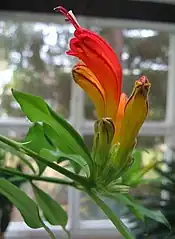
.jpg.webp)
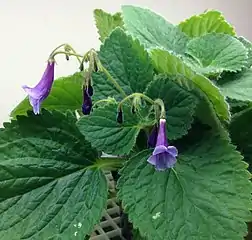 Damrongia orientalis
Damrongia orientalis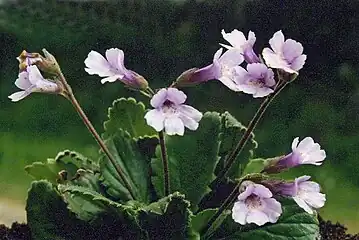
_-_Botanischer_Garten%252C_Dresden%252C_Germany_-_DSC08590.JPG.webp)
 Monophyllaea glauca – each leaf is one separate plant
Monophyllaea glauca – each leaf is one separate plant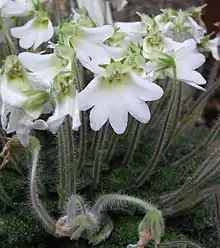
.JPG.webp)
 Rhynchoglossum notonianum
Rhynchoglossum notonianum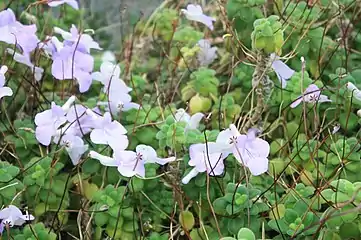
Distribution
The species of the subfamily Didymocarpoideae are native to Europe, Africa, Asia, Malesia, the Pacific and Australia, except for a single species, Rhynchoglossum azureum, which is native to the Neotropics (Central and South America).[2]
References
- ↑ Reveal, James L. (2011) [onwards], "Didymocarpoideae", Indices Nominum Supragenericorum Plantarum Vascularium, Plant Biology section, Cornell University, retrieved 2021-04-14
- 1 2 3 4 5 Weber, A.; Middleton, D.J.; Clark, J.L. & Möller, M. (2020), "Keys to the infrafamilial taxa and genera of Gesneriaceae", Rheedea, 30 (1): 5–47, doi:10.22244/rheedea.2020.30.01.02
External links
 Media related to "Didymocarpoideae" at Wikimedia Commons
Media related to "Didymocarpoideae" at Wikimedia Commons Data related to Didymocarpoideae at Wikispecies
Data related to Didymocarpoideae at Wikispecies